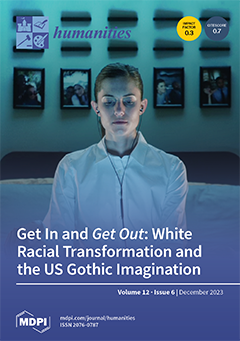In the
Odyssey, Homer’s Penelope and Circe have fundamentally important roles in ensuring the progression and success of the hero’s, Odysseus, journey home. Their actions in the
Odyssey invite complex readings of the two women. Despite this, onscreen Penelope is often depicted
[...] Read more.
In the
Odyssey, Homer’s Penelope and Circe have fundamentally important roles in ensuring the progression and success of the hero’s, Odysseus, journey home. Their actions in the
Odyssey invite complex readings of the two women. Despite this, onscreen Penelope is often depicted as the “good, faithful” wife, and Circe as the “temptress”. Whilst these interpretations are not wrong, they are limited, cultivating a diminutive cultural understanding about Homer’s women. In this article I will use
The Simpsons episode ‘Tales from the Public Domain’ as the foundation of my analysis, whereby I argue that screen adaptations perpetuate these gendered tropes further by relying on what is “known” about these women, instead of investigating their roles in ways that are significantly more complex. To achieve this, I will analyse how gender roles are presented in
The Simpsons’ adaptation of the
Odyssey, with a special focus on Penelope’s and Circe’s interaction with, and relationship to, the story’s hero, Odysseus. I will compare these representations to examples from other screen adaptations from the twentieth and twenty-first centuries, including Mario Camerini’s
Ulysses, Andrei Konchalovsky’s
The Odyssey, and Joel and Ethan Coen’s
O Brother,
Where Art Thou?.
Full article





